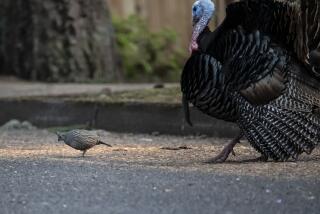Life With Peacocks: Peaceful but Noisy : Birds: They look beautiful, sound awful and have a taste for pizza. About 20,000 Americans keep peafowl as pets.
- Share via
URBANA, Ill. — The tranquillity of a spring afternoon is shattered by the piercing shriek of a peacock, opening his colorful fan of tail feathers for three females.
It is a sound only a peahen could love--sort of a cross between angry cat and agitated crow. But it is a sound Ed Dessen is used to after 16 years.
“They really scream,” says Dessen, a retired photographer who raises peafowl at his secluded home site.
“But they’re beautiful, gentle and they don’t bother anybody,” he adds. “It’s always nice to see people’s eyes pop when they see the peacocks, but I really do it for my own pleasure.”
More than 50 of the magnificent birds roam Dessen’s property, often crossing paths with ducks, geese, swans, wild turkeys and chickens. For the most part, they peacefully coexist.
Even the family’s gray cat, strolling toward the red brick house with a fresh mouse in his mouth, brushes past a peacock as if it were a stuffed bird.
“He doesn’t bother with them; they’re beyond his scale,” Dessen says.
Peacocks and peahens, relatives of the pheasant, have become popular in the United States as ornamental fowl. At least 20,000 people own peafowl, estimates Dennis Fett of Minden, Iowa, co-author of “The Wacky World of Peafowl.”
Fett and his wife, Debra Buck, raise and sell peafowl and have written books and newsletters to help others.
“The main reason people buy them is for their beauty,” Fett says. “When we look at our birds--we have hundreds--there is that stunning beauty that speaks back. I think it does that for everyone.”
Fett says most peafowl get along well with people.
“We have peacocks and peahens that follow us around like puppy dogs,” he says. “They’re lovable and curious.”
Dessen has learned a few things about peafowl on his own. One is that they will eat expensive commercial feed, but a more economical diet will do the job.
“They eat a lot of grass and bugs,” Dessen says. “Unfortunately, they also eat my wife’s flowers. They love anything red.”
He stops to check a metal bin where he stores their favorite food--pizza. Dessen gets up to 2,000 pounds of stale pizza a week from a nearby restaurant.
“They thrive on it,” he says.
In a large walk-in pen, peafowl and their feathered neighbors peck away at the pepperoni.
Peahens lay four eggs a year, but Dessen no longer allows the females to sit on them. He gathers the eggs and hatches them in his incubator.
“They just aren’t very good mothers--they’re inattentive to their young,” he says, noting that animals that wander across the property at night kill the newborn peafowl.
Raccoons are the only real enemy of adult peafowl. They killed all of Dessen’s new peahens one year. “At $50 a copy, I wasn’t very happy.”
The peacocks are very territorial, defending their own areas. One marches up and down the back porch, another struts by a fence. They open their 3-foot tail feathers into a colorful fan when it is time to mate.
“The females all march around him and when one feels like it, she’ll just run up to him,” Dessen says.
The peafowl fit perfectly into the atmosphere of natural beauty Dessen set out to create when he bought the property in 1956.
It was a borrow pit, a huge hole dug to supply dirt for the construction of Interstate 74. Now there are three lakes, a sandy beach, flowering almond, plum and peach trees, and wildlife.
It looks the way Dessen knew the landscape should look when he was growing up in Pennsylvania coal-mining country.
“I couldn’t understand why they had destroyed so much beauty . . . raped the countryside,” says Dessen, who studied ecology at the University of Illinois in the 1940s.
Now, he lives what he learned.
“If I don’t do anything else in my life, my God’s little 11 acres is more precious than anything I’ve done.”
More to Read
Sign up for Essential California
The most important California stories and recommendations in your inbox every morning.
You may occasionally receive promotional content from the Los Angeles Times.










